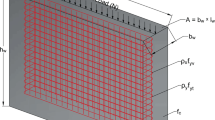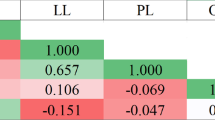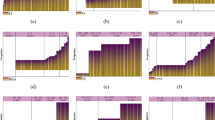Abstract
Reinforced concrete (RC) shear walls play a pivotal role in resisting seismic and lateral loads within structural frameworks. A thorough examination of the existing literature was undertaken, covering a range of experimental and theoretical studies related to the design of RC shear walls. It was emphasized that comprehending shear failure behavior and precisely predicting the shear strength of RC walls holds considerable significance. To address this, the study proposes two models that integrate the support vector regression method with meta-heuristic optimization algorithms (Bat and GOA), utilizing 228 sets of experimental data. In identifying the parameters influencing the shear strength of RC shear walls, the study focused on eight influential factors. The comparison of the two proposed models in the current research with existing models and experimental data demonstrated their commendable accuracy, surpassing the performance of suggested empirical formulations. The prediction errors associated with the proposed models, when compared to experimental data, were notably low. An innovative approach was introduced in the research, presenting a novel method for predicting shear strength using the support vector regression method and the Bat optimization algorithm. A notable advantage of this formulation lies in its capacity to predict the shear strength across various configurations, including squat, cylindrical, and thin RC shear walls. Unlike some existing equations for predicting shear strength, this formulation exhibits no limitations. Through a comparative analysis with established equations, the computational framework’s results suggest its successful applicability in building codes and construction practices. The proposed method contributes to the accurate prediction of shear strength in diverse RC shear wall configurations, offering a valuable tool for structural engineering applications.

























Similar content being viewed by others
Data availability
The raw/processed data required to reproduce these findings cannot be shared at this time as the data also forms part of an ongoing study.
References
Irwin AW, Ord AEC (1976) Cyclic load tests on shear wall coupling beams. Proc Inst Civ Eng. https://doi.org/10.1680/iicep.1976.3442
Barda F, Hanson JM, Corley WG (1977) Shear strength of low-rise walls with boundary elements. Lehigh University, Bethlehem. https://doi.org/10.14359/17697
Saito H, Kikuchi R, Kanechika M, Okamoto K (1989) Experimental study of the effect of concrete strength on shear wall behavior
Salonikios TN, Kappos AJ (1999) Cyclic load behavior of low-slenderness reinforced. ACI Struct J 96:649–660
Matsui T, Kabeyasawa T, Koto A, Kuramoto H, Nagashima I (2004) Shaking table test and analysis of reinforced concrete walls. In: Proceedings of the 13th world conference on earthquake engineering
Gulec CK, Whittaker AS, Stojadinovic B (2008) Shear strength of squat rectangular reinforced concrete walls. ACI Struct J 105:488
Wood SL (1990) Shear strength of low-rise reinforced concrete walls. ACI Struct J 87:99–107. https://doi.org/10.14359/2951
Xiang W (2009) Seismic performance of RC structural squat walls with limited transverse reinforcement
Carrillo J, Alcocer SM (2013) Shear strength of reinforced concrete walls for seismic design of low-rise housing. ACI Struct J 110:415
Park H-G, Baek J-W, Lee J-H, Shin H-M (2015) Cyclic loading tests for shear strength of low-rise reinforced concrete walls with grade 550 MPa bars. ACI Struct J 112:299–310
Kassem W (2015) Shear strength of squat walls: a strut-and-tie model and closed-form design formula. Eng Struct 84:430–438. https://doi.org/10.1016/j.engstruct.2014.11.027
Ngo NT, Le HA, Pham TPT (2021) Integration of support vector regression and grey wolf optimization for estimating the ultimate bearing capacity in concrete-filled steel tube columns. Neural Comput Appl. https://doi.org/10.1007/s00521-020-05605-z
Naderpour H, Parsa P, Mirrashid M (2021) Innovative approach for moment capacity estimation of spirally reinforced concrete columns using swarm intelligence-based algorithms and neural network. Pract Period Struct Des Constr 26:04021043. https://doi.org/10.1061/(asce)sc.1943-5576.0000612
Zhang J, Wang Y (2021) Evaluating the bond strength of FRP-to-concrete composite joints using metaheuristic-optimized least-squares support vector regression. Neural Comput Appl 33:3621–3635. https://doi.org/10.1007/s00521-020-05191-0
Khademi A, Behfarnia K, Šipoš TK (2021) The use of machine learning models in estimating the compressive strength of recycled brick aggregate concrete. Comput Eng Phys Model 4:1–25
Naderpour H, Mirrashid M, Parsa P (2021) Failure mode prediction of reinforced concrete columns using machine learning methods. Eng Struct. https://doi.org/10.1016/j.engstruct.2021.113263
Nayak SC, Nayak SK, Panda SK (2021) Assessing compressive strength of concrete with extreme learning machine. J Soft Comput Civ Eng 5:68–85. https://doi.org/10.22115/SCCE.2021.286525.1320
Yang Y, Cho IH (2021) Multiple target machine learning prediction of capacity curves of reinforced concrete shear walls. J Soft Comput Civ Eng 5:90–113. https://doi.org/10.22115/SCCE.2021.314998.1381
Ly HB, Nguyen MH, Pham BT (2021) Metaheuristic optimization of Levenberg–Marquardt-based artificial neural network using particle swarm optimization for prediction of foamed concrete compressive strength. Neural Comput Appl 33:17331–17351. https://doi.org/10.1007/s00521-021-06321-y
Chen XL, Fu JP, Yao JL, Gan JF (2018) Prediction of shear strength for squat RC walls using a hybrid ANN–PSO model. Eng Comput 34:367–383. https://doi.org/10.1007/s00366-017-0547-5
Parsa P, Naderpour H (2021) Shear strength estimation of reinforced concrete walls using support vector regression improved by teaching–learning-based optimization, particle swarm optimization, and Harris Hawks optimization algorithms. J Build Eng 44:102593. https://doi.org/10.1016/j.jobe.2021.102593
Seif ElDin HM, Aly N, Galal K (2019) In-plane shear strength equation for fully grouted reinforced masonry shear walls. Eng Struct 190:319–332. https://doi.org/10.1016/j.engstruct.2019.03.079
Arafa A, Farghaly AS, Benmokrane B (2018) Evaluation of flexural and shear stiffness of concrete squat walls reinforced with glass fiber-reinforced polymer bars. ACI Struct J 115:211–221. https://doi.org/10.14359/51700987
Carrillo J, Oyarzo-Vera C, Blandón C (2019) Damage assessment of squat, thin and lightly-reinforced concrete walls by the Park & Ang damage index. J Build Eng 26:100921. https://doi.org/10.1016/j.jobe.2019.100921
Huang Z, Shen J, Lin H, Song X, Yao Y (2020) Shear behavior of concrete shear walls with CFRP grids under lateral cyclic loading. Eng Struct 211:110422. https://doi.org/10.1016/j.engstruct.2020.110422
Massone LM, Ostoic DF (2020) Shear strength estimation of masonry walls using a panel model. Eng Struct 204:109900. https://doi.org/10.1016/j.engstruct.2019.109900
Marzok A, Lavan O, Dancygier AN (2020) Predictions of moment and deflection capacities of RC shear walls by different analytical models. Structures 26:105–127. https://doi.org/10.1016/j.istruc.2020.03.059
Hung CC, Hsieh PL (2020) Comparative study on shear failure behavior of squat high-strength steel reinforced concrete shear walls with various high-strength concrete materials. Structures 23:56–68. https://doi.org/10.1016/j.istruc.2019.11.002
Vapnik VN (1995) The nature of statistical learning theory. Springer, New York. https://doi.org/10.1007/978-1-4757-2440-0
Karmy JP, Maldonado S (2019) Hierarchical time series forecasting via support vector regression in the European Travel Retail Industry. Expert Syst Appl 137:59–73. https://doi.org/10.1016/j.eswa.2019.06.060
Pal M, Deswal S (2011) Support vector regression based shear strength modelling of deep beams. Comput Struct 89:1430–1439. https://doi.org/10.1016/j.compstruc.2011.03.005
Azimi-Pour M, Eskandari-Naddaf H, Pakzad A (2020) Linear and non-linear SVM prediction for fresh properties and compressive strength of high volume fly ash self-compacting concrete. Constr Build Mater 230:117021. https://doi.org/10.1016/j.conbuildmat.2019.117021
Bennett KP, Mangasarian OL (1992) Robust linear programming discrimination of two linearly inseparable sets. Optim Methods Softw 1:23–34. https://doi.org/10.1080/10556789208805504
Saremi S, Mirjalili S, Lewis A (2017) Grasshopper optimisation algorithm: theory and application. Adv Eng Softw 105:30–47. https://doi.org/10.1016/j.advengsoft.2017.01.004
Yang XS (2010) A new metaheuristic Bat-inspired algorithm. In: Studies in computational intelligence. Springer, pp 65–74. https://doi.org/10.1007/978-3-642-12538-6_6
Yildizdan G, Baykan ÖK (2020) A novel modified bat algorithm hybridizing by differential evolution algorithm. Expert Syst Appl. https://doi.org/10.1016/j.eswa.2019.112949
Yang XS, Gandomi AH (2012) Bat algorithm: a novel approach for global engineering optimization. Eng Comput (Swansea, Wales) 29:464–483. https://doi.org/10.1108/02644401211235834
Altringham JD (1996) BATS: biology and behaviour. Oxford University Press, New York, p 262
Gandomi AH, Yang XS, Alavi AH, Talatahari S (2013) Bat algorithm for constrained optimization tasks. Neural Comput Appl 22:1239–1255. https://doi.org/10.1007/s00521-012-1028-9
Oesterle RG, Fiorato AE, Aristizabal-Ochoa JD, Corley WG (1980) Hysteretic response of reinforced concrete structural walls. ACI Spec Publ 63:243–273
Oesterle RG, Fiorato AE, Corley WG (1980) Reinforcement details for earthquake-resistant structural walls. Portland Cement Association, Washington
Shiu KN, Daniel JI, Aristizabal-Ochoa JD, Fiorato AE, Corley WG (1981) Earthquake resistant structural walls: test of walls with and without openings. STIN 82:21451
Jiang HJ, Lu XL (1999) Calculating method for the hysteretic characteristics of shear walls dissipating energy along the vertical direction. J Tongji Univ 6
Hube MA, María HS, López M (2017) Experimental campaign of thin reinforced concrete shear walls for low-rise constructions. In: 16th world conference on earthquake
Alarcon C, Hube MA, De la Llera JC (2014) Effect of axial loads in the seismic behavior of reinforced concrete walls with unconfined wall boundaries. Eng Struct 73:13–23
Segura CL Jr, Wallace JW (2018) Seismic performance limitations and detailing of slender reinforced concrete walls. ACI Struct J 115:849–859
Dragan D, Plumier A, Degée H (2018) Experimental study regarding shear behavior of concrete walls reinforced by multiple steel profiles. In: High tech concrete: where technology and engineering meet. Springer, pp 1077–1084
Ganesan N, Indira PV, Seena P (2015) Reverse cyclic tests on high performance cement concrete shear walls with barbells. In: Advances in structural engineering: materials. Springer, pp 2309–2321
Mansur MA, Balendra T, H’ng SC (1992) Tests on reinforced concrete low-rise shear walls under cyclic loading. Concr Shear Earthq 95
Barda F, Hanson JM, Corley WG (1977) Shear strength of low-rise walls with boundary elements. https://doi.org/10.14359/17697
Liu G, Song Y, Qu F (2010) Post-fire cyclic behavior of reinforced concrete shear walls. J Cent South Univ Technol 17:1103–1108
Quiroz LG, Maruyama Y, Zavala C (2013) Cyclic behavior of thin RC Peruvian shear walls: Full-scale experimental investigation and numerical simulation. Eng Struct 52:153–167
Thomsen JH, Wallace JW (1995) Displacement based design of reinforced concrete structural walls: an experimental investigation of walls with rectangular and t-shaped cross-sections: a dissertation
Tran TA, Wallace JW (2012) Experimental study of nonlinear flexural and shear deformations of reinforced concrete structural walls. In: Proceedings, 15th world conference on earthquake engineering, Lisbon, Portland
Layssi H, Mitchell D (2012) Experiments on seismic retrofit and repair of reinforced concrete shear walls. In: Proceedings of the 6th international conference on FRP composites in civil engineering, pp 13–15
Ghorbani-Renani I, Velev N, Tremblay R, Palermo D, Massicotte B, Léger P (2009) Modeling and testing influence of scaling effects on inelastic response of shear walls. ACI Struct J 106:358
Ghazizadeh S, Cruz-Noguez CA, Li Y (2019) Numerical study of hybrid GFRP-steel reinforced concrete shear walls and SFRC walls. Eng Struct 180:700–712
Athanasopoulou A (2010) Shear strength and drift capacity of reinforced concrete and high-performance fiber reinforced concrete low-rise walls subjected to displacement reversals (2010)
Tupper B (1999) Seismic response of reinforced concrete walls with steel boundary elements
Carrillo J, Lizarazo JM, Bonett R (2015) Effect of lightweight and low-strength concrete on seismic performance of thin lightly-reinforced shear walls. Eng Struct 93:61–69
Yuan W, Zhao J, Sun Y, Zeng L (2018) Experimental study on seismic behavior of concrete walls reinforced by PC strands. Eng Struct 175:577–590
Umemura H, Takizawa H (1982) Dynamic response of reinforced concrete buildings. IABSE, Zurich
Greifenhagen C, Lestuzzi P (2005) Static cyclic tests on lightly reinforced concrete shear walls. Eng Struct 27:1703–1712
Looi DTW, Su RKL, Cheng B, Tsang HH (2017) Effects of axial load on seismic performance of reinforced concrete walls with short shear span. Eng Struct 151:312–326
Lopes MS (2001) Experimental shear-dominated response of RC walls. Part II: discussion of results and design implications. Eng Struct 23:564–574
Ghazizadeh S, Cruz-Noguez CA (2018) Damage-resistant reinforced concrete low-rise walls with hybrid GFRP-steel reinforcement and steel fibers. J Compos Constr 22:4018002
Yanez FV, Park R, Paulay T (1991) Seismic behaviour of reinforced concrete structural walls with irregular openings. In: Pacific conference on earthquake engineering, pp 3303–3308
M Bouchon, N Orbovic, N Foure (2004) Tests on reinforced concrete low-rise shear walls under static cyclic loading. In: Proceedings of the 13th world conference on earthquake engineering, p 10
Lefas ID, Kotsovos MD, Ambraseys NN (1990) Behavior of reinforced concrete structural walls. Strength, deformation characteristics, and failure mechanism. ACI Struct J 87:23–31. https://doi.org/10.14359/2911
Lefas ID, Kotsovos MD (1990) Strength and deformation characteristics of reinforced concrete walls under load reversals. ACI Struct J. https://doi.org/10.14359/2994
Pilakoutas K, Elnashai AS (1995) Cyclic behavior of reinforced concrete cantilever walls, part I: experimental results. ACI Struct J 92:271–281
Gupta A, Rangan BV (1998) High-strength concrete (HSC) structural walls. Struct J 95:194–204
Mickleborough NC, Ning F, Chan C-M (1999) Prediction of stiffness of reinforced concrete shearwalls under service loads. Struct J 96:1018–1026
Sittipunt C, Wood SL, Lukkunaprasit P, Pattararattanakul P (2001) Cyclic behavior of reinforced concrete structural walls with diagonal web reinforcement. Struct J 98:554–562
Zhang Y, Wang Z (2000) Seismic behavior of reinforced concrete shear walls subjected to high axial loading. Struct J 97:739–750
Terzioglu T, Orakcal K, Massone LM (2018) Cyclic lateral load behavior of squat reinforced concrete walls. Eng Struct 160:147–160. https://doi.org/10.1016/j.engstruct.2018.01.024
Abdulridha A, Palermo D (2017) Behaviour and modelling of hybrid SMA-steel reinforced concrete slender shear wall. Eng Struct 147:77–89
Qazi S, Michel L, Ferrier E (2019) Seismic behaviour of RC short shear wall strengthened with externally bonded CFRP strips. Compos Struct 211:390–400
Wang W, Wang Y, Lu Z (2018) Experimental study on seismic behavior of steel plate reinforced concrete composite shear wall. Eng Struct 160:281–292
Ren F, Chen J, Chen G, Guo Y, Jiang T (2018) Seismic behavior of composite shear walls incorporating concrete-filled steel and FRP tubes as boundary elements. Eng Struct 168:405–419
Le Nguyen K, Brun M, Limam A, Ferrier E, Michel L (2014) Pushover experiment and numerical analyses on CFRP-retrofit concrete shear walls with different aspect ratios. Compos Struct 113:403–418
Choi CS (2006) Improvement of earthquake-resistant performance of squat shear walls under reversed cyclic loads. In: Key engineering materials. Trans Tech Publication, pp 535–538
Cortés-Puentes WL, Palermo D (2018) Seismic retrofit of concrete shear walls with SMA tension braces. J Struct Eng 144:4017200
Qiao Q, Cao W, Qian Z, Li X, Zhang W, Liu W (2017) Cyclic behavior of low rise concrete shear walls containing recycled coarse and fine aggregates. Materials (Basel) 10:1400
Blandon CA, Arteta CA, Bonett RL, Carrillo J, Beyer K, Almeida JP (2018) Response of thin lightly-reinforced concrete walls under cyclic loading. Eng Struct 176:175–187
Christidis KI, Vougioukas E, Trezos KG (2016) Strengthening of non-conforming RC shear walls using different steel configurations. Eng Struct 124:258–268
Liao F-Y, Han L-H, Tao Z (2012) Performance of reinforced concrete shear walls with steel reinforced concrete boundary columns. Eng Struct 44:186–209
Dazio A, Beyer K, Bachmann H (2009) Quasi-static cyclic tests and plastic hinge analysis of RC structural walls. Eng Struct 31:1556–1571
Zhi Q, Guo Z, Xiao Q, Yuan F, Song J (2017) Quasi-static test and strut-and-tie modeling of precast concrete shear walls with grouted lap-spliced connections. Constr Build Mater 150:190–203. https://doi.org/10.1016/j.conbuildmat.2017.05.183
Shen D, Yang Q, Jiao Y, Cui Z, Zhang J (2017) Experimental investigations on reinforced concrete shear walls strengthened with basalt fiber-reinforced polymers under cyclic load. Constr Build Mater 136:217–229
Zhang J-W, Zheng W-B, Cao W-L, Dong H-Y, Li W-D (2019) Seismic behavior of low-rise concrete shear wall with single layer of web reinforcement and inclined rebars: restoring force model. KSCE J Civ Eng 23:1302–1319
Hidalgo PA, Ledezma CA, Jordan RM (2002) Seismic behavior of squat reinforced concrete shear walls. Earthq Spectra 18:287–308
Zhou A, Qu BY, Li H, Zhao SZ, Suganthan PN, Zhangd Q (2011) Multiobjective evolutionary algorithms: a survey of the state of the art. Swarm Evol Comput 1:32–49. https://doi.org/10.1016/j.swevo.2011.03.001
Gogna A, Tayal A (2013) Metaheuristics: review and application. J Exp Theor Artif Intell 25:503–526. https://doi.org/10.1080/0952813X.2013.782347
Gunn SR (1998) Support vector machines for classification and regression. ISIS Tech Rep 14:5–16
A.C. Institute (2014) Building code requirements for structural concrete (ACI 318-14): commentary on building code requirements for structural concrete (ACI 318R-14): an ACI report, American Concrete Institute. ACI
A.S. of C. Engineers (2005) Seismic design criteria for structures, systems, and components in nuclear facilities (ASCE/SEI 43-05).: introduction; chapter 2 earthquake ground motion; chapter 3 evaluation of seismic demand; chapter 4 evaluation of structural capacity; chapter 5 load. American Society of Civil Engineers
Wang M, Wan W (2019) A new empirical formula for evaluating uniaxial compressive strength using the Schmidt hammer test. Int J Rock Mech Min Sci 123:104094. https://doi.org/10.1016/j.ijrmms.2019.104094
Ali M, Zhu P, Jiang R, Huolin M, Ehsan M, Hussain W, Zhang H, Ashraf U, Ullaah J (2023) Reservoir characterization through comprehensive modeling of elastic logs prediction in heterogeneous rocks using unsupervised clustering and class-based ensemble machine learning. Appl Soft Comput 148:110843. https://doi.org/10.1016/j.asoc.2023.110843
Ali M, Zhu P, Huolin M, Pan H, Abbas K, Ashraf U, Ullah J, Jiang R, Zhang H (2023) A novel machine learning approach for detecting outliers, rebuilding well logs, and enhancing reservoir characterization. Nat Resour Res 32:1047–1066. https://doi.org/10.1007/s11053-023-10184-6
Gandomi AH, Roke DA, Sett K (2013) Genetic programming for moment capacity modeling of ferrocement members. Eng Struct 57:169–176. https://doi.org/10.1016/j.engstruct.2013.09.022
Naderpour H, Rezazadeh Eidgahee D, Fakharian P, Rafiean AH, Kalantari SM (2019) A new proposed approach for moment capacity estimation of ferrocement members using group method of data handling. Eng Sci Technol Int J. https://doi.org/10.1016/j.jestch.2019.05.013
Naderpour H, Kheyroddin A, Amiri GG (2010) Prediction of FRP-confined compressive strength of concrete using artificial neural networks. Compos Struct 92:2817–2829. https://doi.org/10.1016/j.compstruct.2010.04.008
Naderpour H, Mirrashid M (2018) An innovative approach for compressive strength estimation of mortars having calcium inosilicate minerals. J Build Eng 19:205–215. https://doi.org/10.1016/j.jobe.2018.05.012
Kalman Sipos T, Parsa P (2020) Empirical formulation of ferrocement members moment capacity using artificial neural networks. J Soft Comput Civ Eng 4:111–126. https://doi.org/10.22115/scce.2020.221268.1181
Funding
This research received no external funding.
Author information
Authors and Affiliations
Corresponding author
Ethics declarations
Conflict of interest
We have no conflicts of interest to disclose.
Additional information
Publisher's Note
Springer Nature remains neutral with regard to jurisdictional claims in published maps and institutional affiliations.
Rights and permissions
Springer Nature or its licensor (e.g. a society or other partner) holds exclusive rights to this article under a publishing agreement with the author(s) or other rightsholder(s); author self-archiving of the accepted manuscript version of this article is solely governed by the terms of such publishing agreement and applicable law.
About this article
Cite this article
Parsa, P., Naderpour, H. & Ezami, N. A novel formulation for predicting the shear strength of RC walls using meta-heuristic algorithms. Neural Comput & Applic 36, 8727–8756 (2024). https://doi.org/10.1007/s00521-024-09514-3
Received:
Accepted:
Published:
Issue Date:
DOI: https://doi.org/10.1007/s00521-024-09514-3




